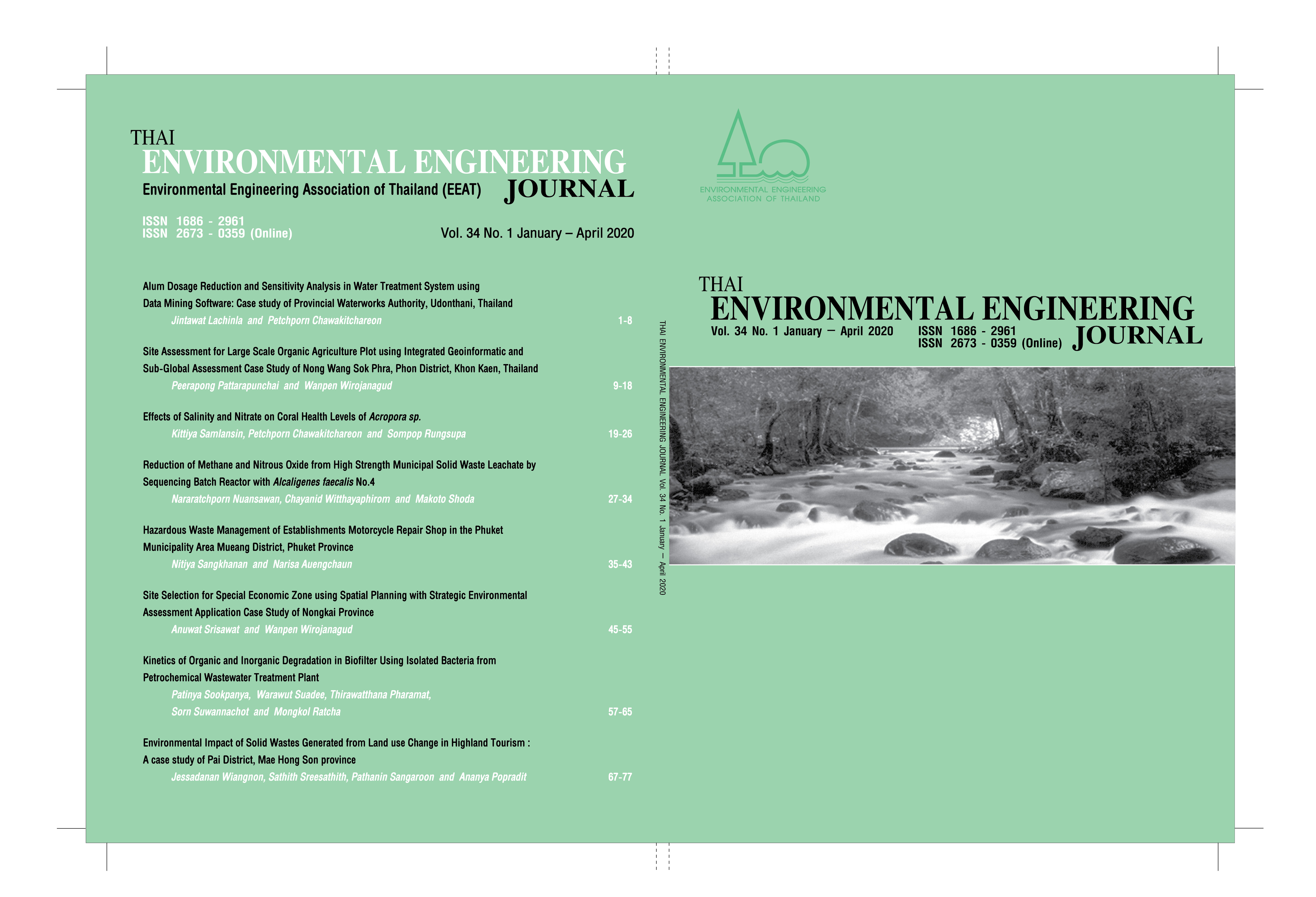Reduction of Methane and Nitrous Oxide from High Strength Municipal Solid Waste Leachate by Sequencing Batch Reactor with Alcaligenes faecalis No.4
Main Article Content
Abstract
This research investigated the performance and greenhouse gas emission from high strength municipal solid waste (MSW) leachate by sequencing batch reactor(SBR) with Alcaligenes faecalis No.4 (A. faecalis No.4). The SBR was carried out by anaerobic reactor followed by aerobic reactor. The system was operated at hydraulic retention times (HRT) of 2 days during 130 operating days (Run 1) and 45 days with A. faecalis No.4 (Run 2). At steady state, the organic removal efficiencies were found to be 62.7% for (Run 1) and 86.7% for (Run 2). The organic carbon and nitrogen were mainly removed in aerobic reactor. The surface emission rates of methane and Nitrous oxide in aerobic reactor were reduced 35% and 14%, respectively with A. faecalis No.4
Article Details
References
Wang, X., M. Jia, X. Chen, Y. Xu, X. Lin, C.M. Kao and S. Chen. 2014. Greenhouse gas emissions from landfill leachate treatment plants: A comparison of young and aged landfill. Waste Manage. 34: 1156-1164.
Chamchoi, N. and S. Nitisoravut. 2007. Anammox enrichment from different conventional sludges. Chemosphere. 66: 2225–2232.
Jaramillo, F., M. Orchard, C. Munoz, M. Zamorano and C. Antileo. 2018. Advanced strategies to improve nitrification process in sequencing batch reactors - A review. J. Environ. Manage. 218: 154-164.
Yan, X., L. Li, and J. Liu. 2014. Characteristics of greenhouse gas emission in three full-scale wastewater treatment processes. J. Environ. Sci. 26: 256-263.
Nuansawan, N., J. Boonnorat, W. Chiemchaisri, and C. Chiemchaisri. 2016. Effect of hydraulic retention time and sludge recirculation on greenhouse gas emission and related microbial communities in two-stage membrane bioreactor treating solid waste leachate. Bioresour. Technol. 210: 35-42.
Lin, L., Lan, C.Y., Huang, L.N., Chan, G.Y.S. 2008. Anthropogenic N2O production from
landfill leachate treatment. J. Environ. Manage. 87: 341–349.
Kampschreur, M.J., N.C.G. Tan, R. Kleerebezem, C. Picioreanu, M.S.M. Jetten, and M.C.M. van Loosdrecht. 2008. Effect of dynamic process conditions on nitrogen oxides emission from a nitrifying culture. Environ. Sci. Technol. 42: 429-435.
Aboobakar, A., E. Cartmell, T. Stephenson, M. Jones, P. Vale, and G. Dotro. 2013. Nitrous oxide emissions and dissolved oxygen profiling in a full-scale nitrifying activated sludge treatment plant. Water Res. 47: 524-534.
Gupta, S.K. and M. Kshirsagar. 2000. Quantitative estimation of Thiosphaera pantotropha from aerobic mixed culture. Water Res. 34: 3765-3768.
Shoda, M. and Y. Ishikawa. 2015. Heterotrophic nitrification and aerobic denitrification of a Wastewater from a Chemical Company by Alcaligenes faecalis No.4. Int. J. Water and Wastewater Treatment. 1.2:1-5
Joo, H.S., M. Hirai and M. Shoda. 2005. Characteristics of ammonium removal by hetetropic nitrification- aerobic denitrification by Alcalisgenes faecalis no.4. J. Biosci. Bioeng. 100: 184-191.
Shoda, M. and Y. Ishikawa. 2014. Heterotrophic nitrification and aerobic denitrification of high-strength ammonium in anaerobically digested sludge by Alcaligenes faecalis strain No.4. J. Biosci. & Bio. Eng. 117(6): 737-741.
APHA . 2005. Standard Methods for the Examination of Water and Wastewater. 21st Edn, American Public Health Association/ American Water Works Association/ Water Environment Federation. Washington, D.C.
Joo, H.S., M. Hirai and M. Shoda. 2006. Piggery wastewater treatment using Alcalisgenes faecalis strain no.4 with heterotrophic nitrification and aerobic denitrification. Water Res. 40: 3029-3036.
Itokawa, H., K. Hanaki and T. Matsuo. 2001. Nitrous oxide production in high-loading biological nitrogen removal process under low COD/N ratio condition. Water Res. 35: 657–664.


